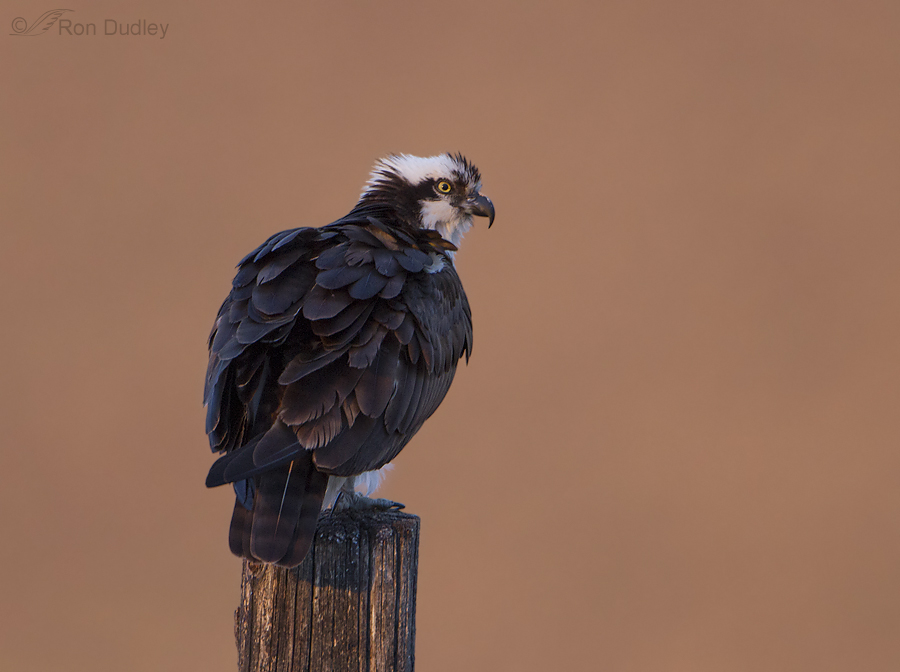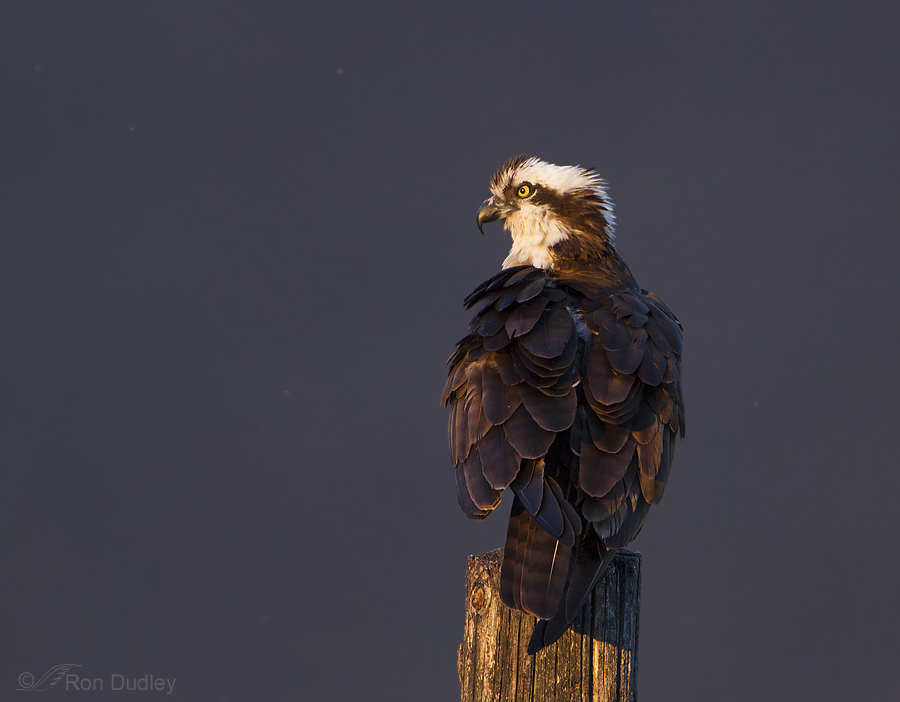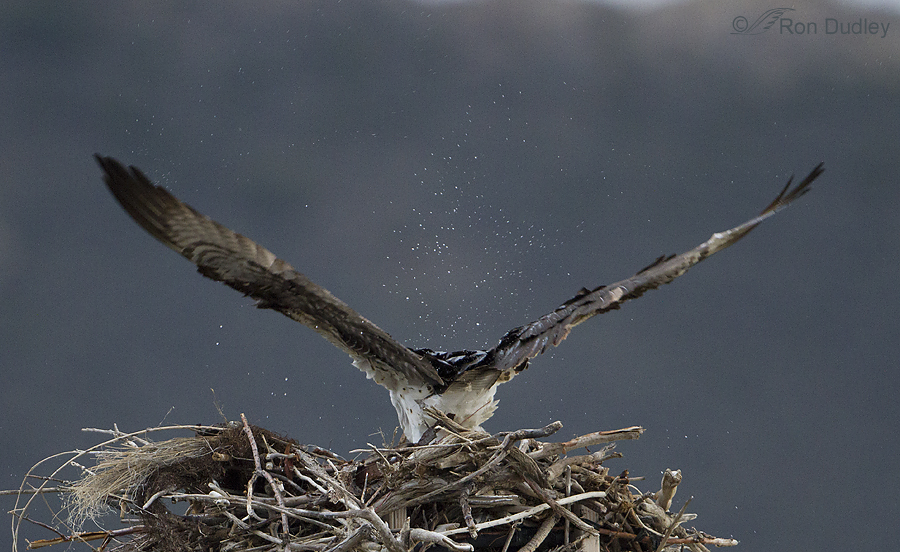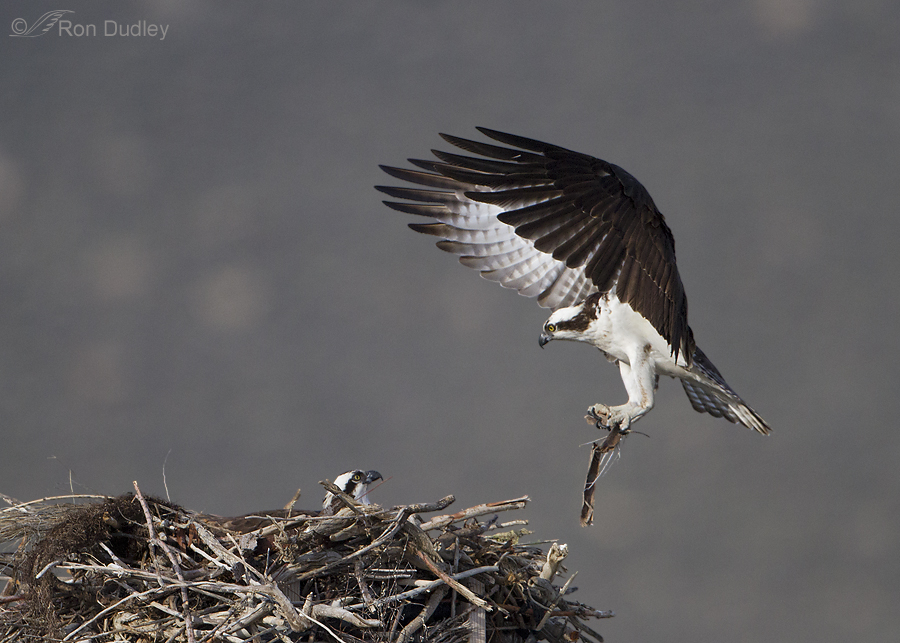Every bird photographer has horror stories about potentially great opportunities with birds that were ruined to some degree or another by tough shooting conditions. Well I met my match on my recent trip to Flaming Gorge. I believe that this trip had the most challenging light, weather and other factors I’ve ever faced on an extended camping/photo trip – even beating trips to Montana when I was photographing Short-eared Owls.
Occasionally I had good light (and I got some shots that I like a lot, even under challenging conditions) but one of the problems was that the light changed so fast and so often. For days ! Much of the time the birds were flying against partly cloudy skies which constantly changed the background, thus the exposure. And then the mountain would instantly become the background which usually had mottled light and was darker than the sky so exposure requirements often changed several times per second in both situations. Since I shoot in aperture priority this meant many blown shots (and cuss words).
The following two images illustrate some of these changing conditions with a perched Osprey.
1/160, f/5.6, ISO 800, 500 f/4, 1.4 tc, natural light, not baited, set up or called in
I mentioned in my previous post that we had about 5 minutes of light at dawn on our last morning before the sun rose into the clouds. Here the very warm light from the rising sun has hit the mountain background and turned it this glowing burnt-orange color. Most of the light hasn’t reached the bird yet, just enough to give it pretty good detail. (I have cloned out a wire attached to the perch in both shots so that it doesn’t distract from my point about light).
1/250, f/5.6, ISO 800, 500 f/4, 1.4 tc, natural light, not baited, set up or called in
Approximately one minute later there is this extremely dramatic change – same bird and perch and I haven’t moved my shooting position. The sun has risen into the clouds enough to put the mountain in the background in shade but now there’s good light on the bird. And it’s now raining, as you can see in the background (particularly at upper left). This kind of thing was almost constantly occurring in the three days we were with these birds.
1/1000, f/4, ISO 1250, 500 f/4, natural light, not baited, set up or called in
The rain presents its own challenges to both bird and photographer. When it’s raining hard enough image quality can suffer because of the raindrops between lens and subject and if the wind’s blowing (as it was) you can’t keep water drops off your lens even with the lens hood in place. But I shouldn’t complain – I was shooting out of my pickup and stayed dry (unlike my lens poking out the window) but the best the poor Osprey on eggs could do was shake herself off occasionally and go back to work (I think this was the female).
1/8000, f/4, ISO 800, 500 f/4, natural light, not baited, set up or called in
I did get quite a few shots that I like but with the constantly changing conditions I was often just lucky. This image is a case in point. Here the male (lack of a prominent necklace) is delivering more nesting material (juniper bark) to the nest as the female incubates. But check out my camera settings. 1/8000 second at ISO 800? – gimme a break! Just before this shot was taken I’d been shooting in much less light and then the sun came out in a nanosecond and I had the choice – change my settings and risk missing the shot while I made the adjustments or take my chances. I chose the latter and this time it worked out but usually it didn’t.
The shooting challenges of this trip were numerous but I think I’m beginning to sound like I’m complaining so I’ll only briefly mention one more. I don’t have a lot of experience with Ospreys but I’ve NEVER seen a species that spends so much time preening. Both birds, male and female, would preen for many hours each day – usually while on an ugly perch and too far away for photography as the mate incubated. Waiting for hours for such a bird to take off in order to get a shot that you like takes some patience. I certainly don’t begrudge them their grooming, I’m just stating what I observed. I suspect that they spent more time grooming than I’m used to seeing in other species because of the rain and also because of the abuse their feathers take on impact when they dive for fish.
I learned some valuable photography lessons from these birds and now that my frustrations are behind me I’ll give them their due and thank them for the education. And for the time they allowed me to spend with them – they’re truly magnificent raptors.
Ron






And I echo the comments about bad weather, photographing now in the Pacific Northwest. I didn’t realize how good I had it in California. 🙂 Still … I’ll take photos of Ospreys, any which way. Love these birds!
Ron- I echo Dave’s sentiments concerning the poor weather. I’m constantly frustrated in shooting in the Northeast because we rarely get good light and clear conditions regularly- read that to mean when I want to go out to shoot. So I understand your frustration, but you still made some terrific images. I’m happy with one decent image-you pulled off several, comgrats!
they are stunning creatures. what a treat to see them and take such excellent photos!
Splendid light in the second photo!
Superb shots, Ron! Especially under such challenging conditions. You’re right about the preening. Ospreys have to continually preen and use secretions from an oil gland to keep their feathers waterproofed. But it does seem like forever when you’re waiting for a shot!
What a beautiful setting (from your previous post)! Wow!
Hey, Wally. I watched them quite a bit as they were preening but didn’t often see them using the pineal gland to oil the feathers. I think they were just trying to aggravate me by making me wait… 🙂
Even though Ospreys are incredibly common here, they’re still one of my favorite birds. Nice shots.
Scott, I love hearing that they’re “incredibly common” somewhere because they certainly aren’t here and I remember when their populations were so threatened just a few decades ago.
I absolutely love the last two shots. They are both extraordinary. I also find it interesting to see the apparent difference in plumage coloration with the different lighting.
Thanks, Susan. As you mention, lighting can make all the difference.
Ron:
We should compare bad words. I empathize with your frustration. On my recent trip to High Island there was a fall-out of migratory birds. Warblers everywhere. Sky totally overcast, light rain, winds 30 knots with higher gusts. The next day, less wind, no rain, but no additional light until very late in the afternoon. Hyperactive birds and dense foliage added to the frustration.
To recover from the frustration, a week later I went to a rookery in Louisiana to salve my wounds by taking photos of BIG birds sitting on a nest.
Ditto Elephant’s Child comment – the challenging conditions make you really appreciate the stunning photos you were able to get.
Dave
You’re right, Dave – all of us bird photographers have those frustrations, of one kind or another. But I’ve seen what you’ve done with “hyperactive birds” in tough conditions so I know you deal with them very well. It would be fun to “compare bad words” over a toddy one day…
As a wildlife artist, I’m always on the hunt for good reference material. I used to backpack and hike in all kinds of terrain and, boy do I miss it! Now I’m old, fat and falling apart…recently turned 80…and rely on others to “take me back”. Your magnificent photos do that for me. The detail on the osprey is so great, I can count the feathers…and believe me, I do.
Loved the comment, Patty. I’m getting up there in years too but I’m glad I can still get “out there” with the birds. I enjoyed “taking you back”…
Lucky, Lucky, Lucky – I empathize, been there, have had that happen to me, most of the time I lose!
Very nice shots under extreme conditions, congratulations!!
Thanks, Dick. I agree, luck was on my side, particularly for that last image.
Challenging conditions yes, but stunning photos. And it is always good to keep in practise with those bad words – you never know when they will be needed.
Magnificent raptors seems almost an understatement.
I really don’t need much practice with those “bad words”, Elephant’s Child – in situations like this they seem to just come naturally… 🙂
Well, I have no photography experience, but I did have a rule (after a sad episode) that NO ospreys were to be sent to us for rehab. These birds go down so quickly that rehabbing more than an hour from vet. care is a disaster.
(By vet. care I mean specialist vet.)
But your shots are stunning!
Diane, Interesting – I had no idea they were so fragile to work with in rehab.